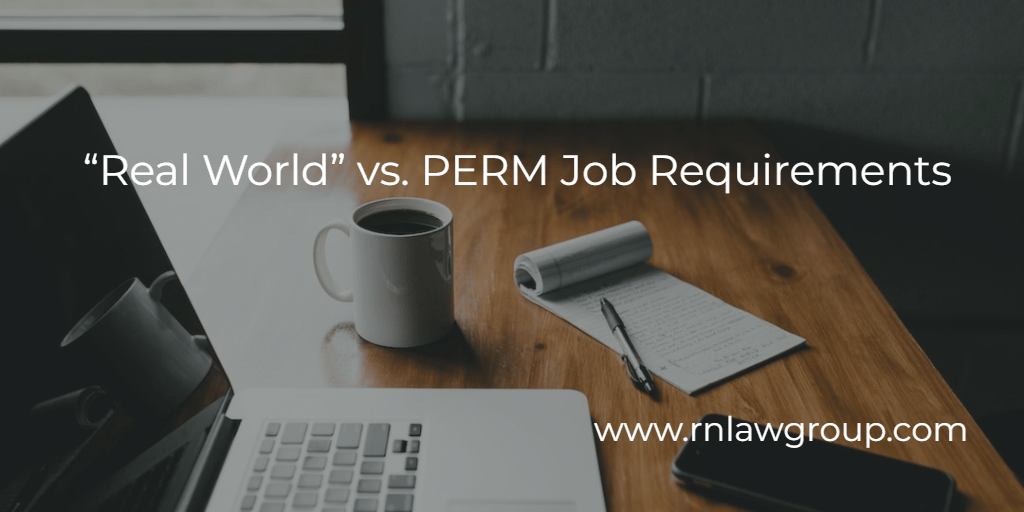
“Real World” vs. PERM Job Requirements
When dealing with “real world” recruiting and hiring, it makes perfect sense that employers are actively seeking the most qualified candidates for a position and have a long list of preferred qualifications and skills that would make a person a perfect match for their company. Often, the reason between choosing one potential hire over another may come down to a subjective determination on which person would fit best within a company, not only based on qualifications and skills, but on personality type and other interpersonal factors. This well-ingrained and common practice often makes it difficult for employers to understand how recruiting and hiring happens during the PERM process as it is a very different undertaking. During the recruitment process when dealing with PERM, regulations dictate employers must look only at the actual minimum qualifications for an open position and nothing more.
According to the Department of Labor regulations, the PERM process was established in order to protect U.S. workers. At its core, the objective of the PERM process is to prove to the Department of Labor that the foreign worker to be hired will not displace any U.S. workers, and this is shown through a good-faith test of the labor market. The ultimate goal of the PERM process is to establish that there are no “able, willing, qualified, and available” U.S. workers to fill the offered position.
To show that no “able, willing, qualified, and available” U.S. workers can fill the open position, the sponsoring employer must conduct good-faith recruitment. The first, and often most important, step in this good-faith recruitment is figuring out the minimum requirements for the open position when advertising to the U.S. labor market. The actual minimum education and experience requirements cannot include any “preferred” qualifications. The simplest way to determine if a requirement is an actual minimum qualification or a preferred qualification would be to have an employer ask themselves the following: What are the bare minimum qualifications that the company needs a prospective hire to have to be able to function in a reasonable manner in the position? If this particular employee was no longer available and we needed to find a replacement as soon as possible, what are the minimum credentials that a new employee would need to have to perform the job duties?
The PERM regulations also necessitate that the minimum job requirements be quantifiable. An example of a quantifiable job requirement would be requiring a specific number of years of experience in a certain field or with a specific software operation system or programming language. Rather than simply stating that “extensive experience with Javascript” is required, to quantify the job requirement, an employer would need to state that “two years of experience with Javascript” is required. When looking at the recruitment process from the perspective of the Department of Labor, it would be difficult to determine if a fair test of the labor market had been conducted if potential applicants were turned away from the position because their experience with Javascript was not “extensive” enough. The definition of “extensive” can vary between people and situations. It is much clearer, and easier, to see that good-faith recruitment was conducted if the potential applicants were not given the position because they only had 6 months of experience with Javascript when two years was stated as mandatory.
If an employer cannot reasonably quantify the job requirements, those job requirements should not be included in the job description – no matter how important these qualifications might seem when conducting “real world” recruitment. While finding a potential hire with “excellent written and verbal communication skills” or “strong technical problem solving and reasoning skills” and the “ability to work in a fast-paced environment” sounds like exactly what an employer would like to do when filling an open position, these subjective terms should not be added. When hiring in a “real world” situation, employers can require and list whatever they wish, but when dealing with a PERM recruitment situation, all requirements must be quantifiable and clearly expressed.
Another important aspect of determining the actual minimum requirements, is to look at previously hired workers now working in the same or a substantially comparable position. An employer cannot have hired workers with less training, less experience, or less education than they are now requiring the foreign worker to have. If when looking at all previous employees hired for the same position, these employees all have Bachelor’s degrees while the foreign worker has a Master’s degree, the actual minimum requirement for the position is a Bachelor’s degree and the employer should not require a Master’s degree.
On the other hand, an employer cannot require more from a U.S. worker applicant than what the foreign worker possesses at the time of hire. If the foreign worker is already employed by the employer, when determining if the job requirements actually represent the actual minimum requirement of the position, the Department of Labor will examine the qualifications of the foreign worker at the time of their hire. If the foreign worker was hired 2 years ago only with a Bachelor’s degree and had no prior experience, the employer cannot now state the minimum requirements for the position are a Bachelor’s degree and 2 years of experience. While the foreign worker may now have 2 years of experience, at the time of hire, the foreign worker had zero years of experience. The employer hired the foreign worker for the position without any work experience, therefore, this is the actual minimum requirement for the position.
The PERM process can be difficult and tricky to navigate as at times it may seem to go against tried and true “real world” hiring practices that most employers follow. In order to ensure the success of a PERM application from the very start, employers should seek advice and counsel from experienced business immigration attorneys who can help translate “real world” job requirements into quantifiable requirements to satisfy the Department of Labor. For over 25 years, Reddy Neumann Brown PC has focused solely on U.S. employment-based immigration, and works with employers to establish best practices when dealing with PERM based recruitment.
By: Jessica Palarca
Jessica Palarca is an attorney in Reddy Neumann Brown’s PERM Labor Certification Department where she assists clients in the beginning stages of the green card process.
Jessica earned her J.D. from the University of Houston Law Center in 2009 and was admitted into the Texas bar the same year. As the child of two immigrant parents, Jessica found her passion for immigration law early in her career. With over a decade of experience in both the private and non-profit sectors, she brings a different perspective to each case she handles. Through the years, Jessica has learned that to achieve the best possible results for each individual served, one must keep things simple and provide personalized attention and care to each case.

